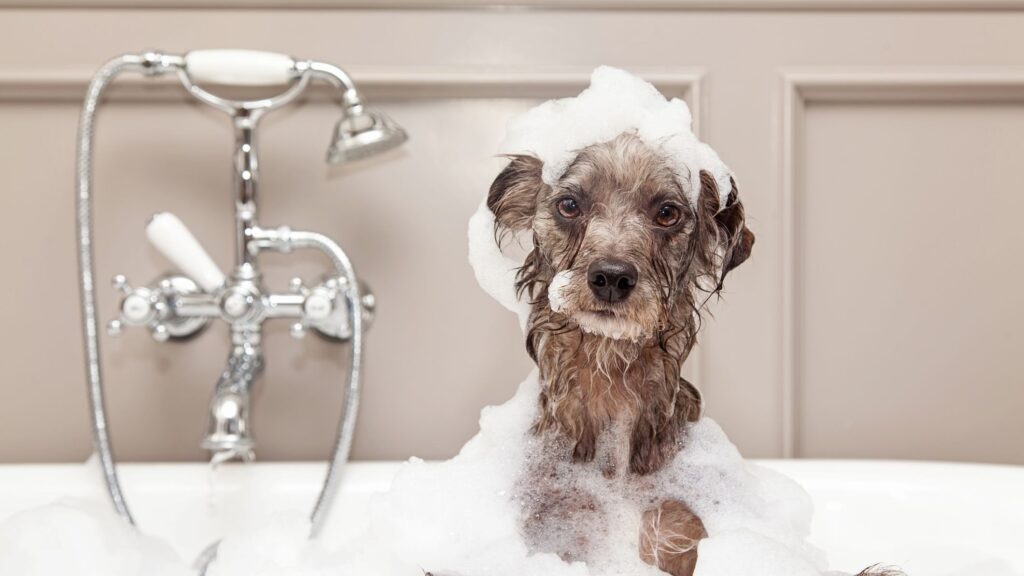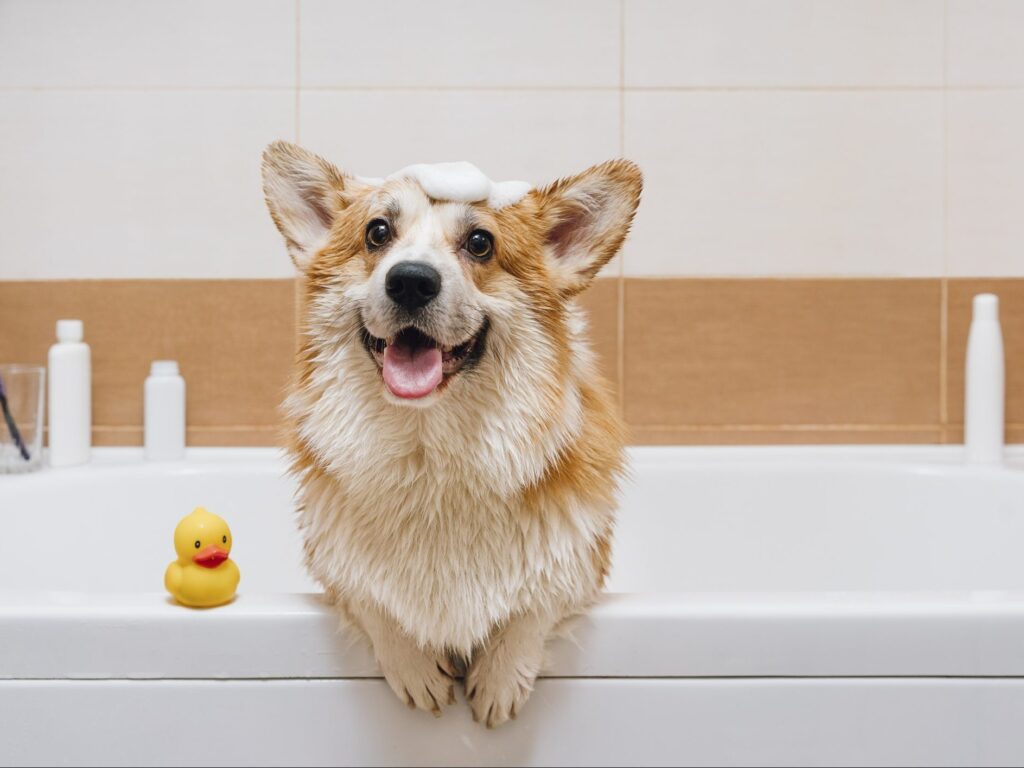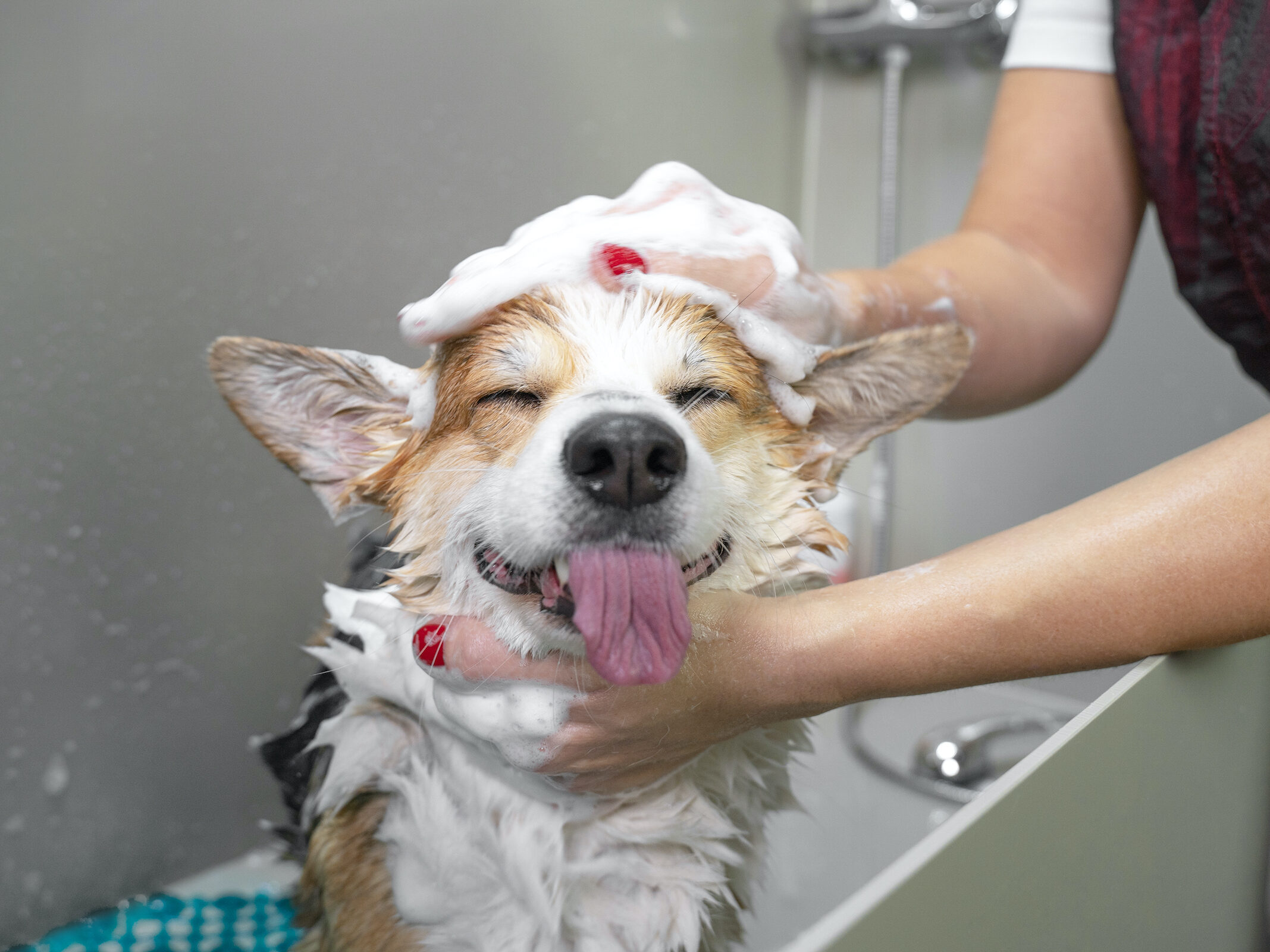The wagging tails, the infectious playfulness, and the unconditional love—our dogs bring immeasurable joy to our lives. As devoted pet parents, ensuring their well-being is paramount, and one question often arises: How frequently should we give our furry friends a bath? The answer isn’t one-size-fits-all; it’s a careful balance between hygiene and their unique needs.

In this article, we embark on a journey to uncover the secrets of doggy baths. We’ll explore variables that influence bathing schedules, consider coat types and lifestyles, and draw insights from expert veterinarians. Armed with this knowledge, you’ll confidently stride into the world of doggy hygiene, keeping your canine companion clean, cozy, and content. So, let’s dive into the delightful realm of keeping your pup pampered and pristine.
Table of Contents
- Factors That Affect Your Dog’s Bathing Frequency
- How To Bathe Your Dog?
- How to Keep Your Dog Calm During Bath Time
- FAQs
- 1. How often should I bathe my dog?
- 2. Can I use human shampoo on my dog?
- 3. What if my dog hates baths?
- 4. How do I dry my dog properly?
- 5. Can I bathe a puppy?
- 6. Should I clean my dog’s ears during a bath?
- 7. What if my dog gets water in their ears or eyes?
- 8. Can I use a hair dryer on my dog?
- 9. Why is positive reinforcement important?
- 10. Should I consult a veterinarian about my dog’s bathing routine?
- Conclusion
Factors That Affect Your Dog’s Bathing Frequency
There is no universal rule for how frequently you should bathe your dog. When it comes to bathing, each dog has individual demands and preferences. Some dogs may require more frequent baths than others, while others may not require any baths at all. [1]
Here are some things to think about when considering how often to bathe your dog:
Breed:
Your dog’s breed can influence how often they need a bath, as different breeds have different types and lengths of coats.
Dogs with long or thick coats, like Golden Retrievers or Huskies, may require more regular bathing than dogs with short or smooth hair, like Beagles or Pugs. This is due to the fact that longer or thicker coats can trap more dirt, oil, and stink than shorter or smoother coats.
This is not to say that you should over-bathe your dog, as doing so can strip away the natural oils and moisture from their skin and coat, causing dryness, irritation, or infection.
Coat type:
Because different coat types have varied qualities and needs, your dog’s coat type might also influence how frequently they need to be bathed. Dogs with curly or wiry coats, like Poodles or Terriers, may require more regular bathing than dogs with straight or smooth coats, like Maltese or Yorkies.
This is due to the fact that curly or wiry coats mat or tangle more quickly than straight or silky coats. This is not to say that you should wash your dog’s coat forcefully or use harsh products, since this might damage their hair follicles and cause breakage or hair loss.

Lifestyle:
Your dog’s lifestyle can also influence how often they need a bath, as different lifestyles expose them to different levels of dirt and odor. Dogs that spend more time outside or have active jobs, such as hunting or herding dogs, may require more frequent baths than dogs who spend the majority of their time indoors or have inactive lifestyles.
This is because outdoor or active dogs can become dirtier or smellier as a result of their surroundings or activity than indoor or inactive dogs. This does not, however, imply that you should bathe your dog every time they get dirty or smelly, as this can be stressful and needless for them. Brushing is another option for keeping them clean in between baths.
Health condition:
Your dog’s health condition can also affect how often they need a bath, as some health conditions may require more or less bathing than others. Dogs with skin issues, such as allergies, infections, or parasites, may require more regular bathing than dogs with healthy skin.
Bathing can help soothe their skin, eliminate allergies, kill bacteria, and get rid of parasites. However, before bathing your dog with a health concern, you should always contact with your veterinarian, as they may recommend special products or instructions for your dog’s treatment.
How To Bathe Your Dog?
Timing and Location:
Select a time and location that is convenient for both you and your dog. Bathe them when they are hungry, weary, or excited, and keep the habitat well-lit and ventilated.[2]
Prep Your Dog:
Brush their coat, trim nails, and clean ears. To keep them calm and cooperative, reassure them with praise, sweets, or toys.
Wetting:
Use warm water to wet the skin, avoiding the head, face, and ears. Check the water temperature and stay away from sensitive regions.
Shampoo:
Use a gentle dog shampoo that is free of harsh ingredients. Apply, lather, and leave on as directed.
Rinsing:
Thoroughly rinse, removing all shampoo residue. Be gentle when it comes to the head and face.
Conditioning:
For a soft coat, use a dog conditioner. Apply, massage, and listen to the instructions.
Drying:
Towel dry, avoiding harsh rubbing. Keep a safe distance and avoid sensitive regions when using a low heat hair dryer.
Positive reinforcement:
Reward your dog’s cooperation with goodies, praise, and cuddles.
How to Keep Your Dog Calm During Bath Time
Some dogs could experience anxiety or fear when getting bathed. They might struggle, resist, or try to run away as a result. You might try any of these suggestions to help your dog remain calm while getting a bath:

- Gradually introduce bathing to your dog. To begin, use water and a sponge or washcloth to get them accustomed to being wet. After that, add some shampoo and gradually lengthen the bath.
- Use constructive criticism. Before, during, and after the bath, reward your dog with snacks. Make bathing seem enjoyable and gratifying to them.
- Do not reprimand or punish your dog for acting uneasy or inappropriately during the bath. This will simply increase their anxiety and afraid as a result.
- While your dog is getting a bath, listen to calming music or speak calmly to them. They may feel more at ease and relaxed as a result.
- Use a relaxing product, such as a diffuser, collar, or pheromone spray. These goods imitate the organic molecules that canines naturally release to communicate comfort and safety. They can support relaxation and help dogs feel less anxious.
FAQs
1. How often should I bathe my dog?
The frequency depends on factors like breed, coat type, and lifestyle. Generally, bathing every 4-8 weeks is a good starting point, but consult your vet for personalized advice.
2. Can I use human shampoo on my dog?
It’s best to use a shampoo formulated for dogs. Human shampoos may contain ingredients that could irritate your dog’s skin or coat.
3. What if my dog hates baths?
Introduce bath time gradually, offering treats and positive reinforcement. Patience and consistency can help them associate bathing with a positive experience.
4. How do I dry my dog properly?
Towel-dry gently, avoiding harsh rubbing. If using a hair dryer, keep it on a low heat setting and maintain a safe distance to prevent discomfort or overheating.
5. Can I bathe a puppy?
Yes, but be sure to use a gentle puppy shampoo and make the experience positive to set a good precedent for future baths.
6. Should I clean my dog’s ears during a bath?
Yes, cleaning ears can be part of the bathing routine. Use a damp cloth or a dog-specific ear cleaner, but avoid going too deep into the ear canal.
7. What if my dog gets water in their ears or eyes?
Gently dry or wipe the areas with a clean, dry cloth to prevent discomfort or irritation.
8. Can I use a hair dryer on my dog?
Yes, but use a low heat setting and keep it at a safe distance. Always monitor your dog’s reaction to ensure they’re comfortable.
9. Why is positive reinforcement important?
Rewarding your dog with treats, praise, and affection helps them associate bathing with a positive experience, making future baths easier.
10. Should I consult a veterinarian about my dog’s bathing routine?
Yes, especially if your dog has specific skin conditions, allergies, or sensitivities. Your vet can offer tailored advice for your dog’s unique needs.
Conclusion
Bathing your dog isn’t just about hygiene – it’s an opportunity to bond and nurture their well-being. By following these tips, you’ve gained the tools to create a positive bathing experience that keeps your furry friend clean, happy, and comfortable.
Remember, each dog is unique, so adapt these steps to suit their temperament and preferences. With practice, patience, and a splash of love, you’ll master the art of doggy baths and enhance the quality of your pet-parenting journey.
References:
- Bathing. (n.d.). Barkley. Bathing-guided
- Office of Web Communications, Cornell University. (n.d.). Vet school dog wash. Cornell. Cornell-university-source


